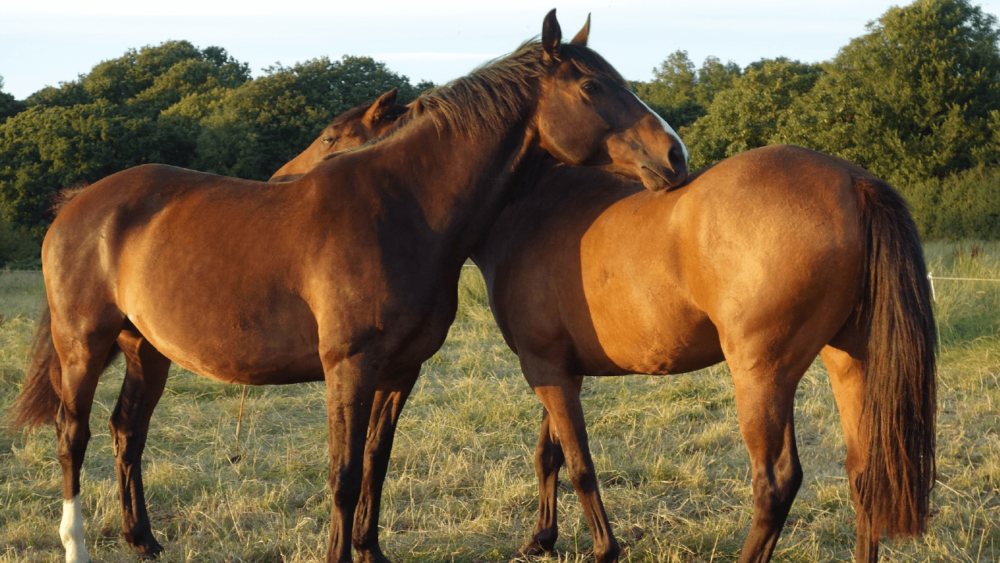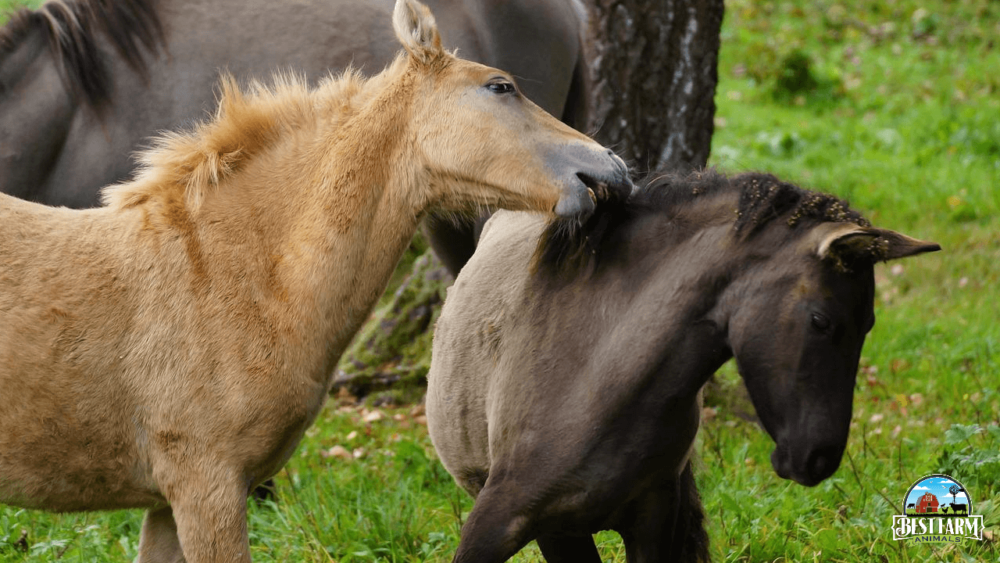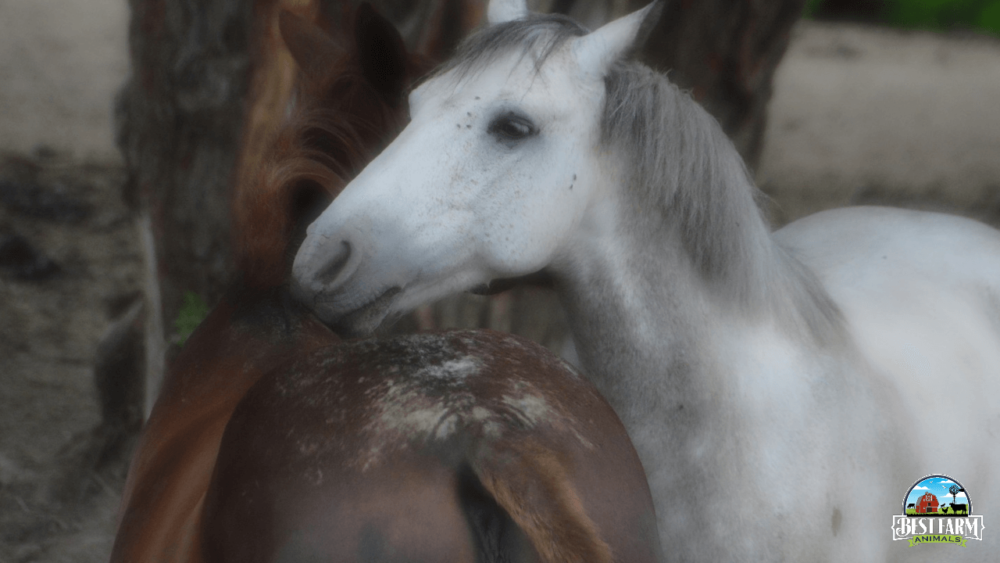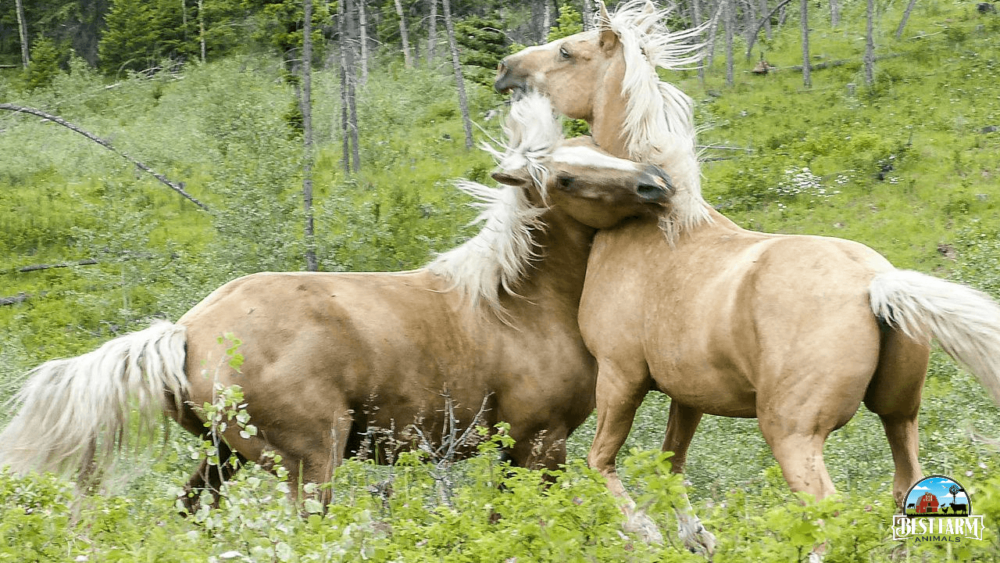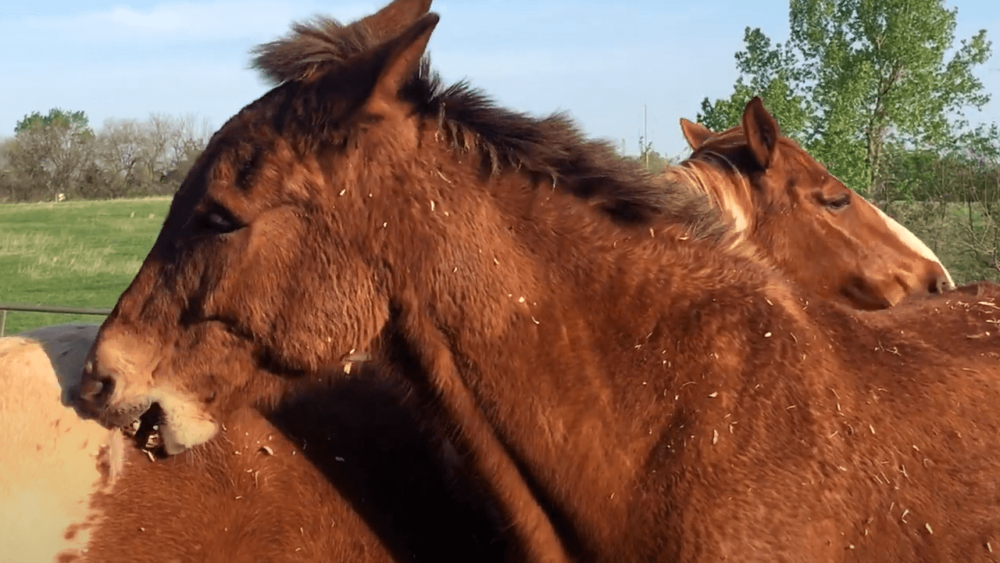You glance out the window to see your two horses frolicking in the field, playing. Suddenly they stand close together like a mirror image, and one stretches her neck out to plant small, repetitive bites on her companion’s rump. The gelding mimics her, and for several minutes they’re lost to the world as they groom each other.
What is horse allogrooming? Allogrooming is social grooming between two horses. They nip with their incisors along the necks or withers. Usually only bonded horses engage in social (mutual) grooming with each other. It increases bonding and establishes social hierarchies.
Ready to learn more about allogrooming? Read on!
What Is Allogrooming?
Allogrooming is when two animals of the same species engage in reciprocal cleaning and grooming. It isn’t only for hygienic purposes, although this is important for many species.
Allogrooming is a valuable social activity. Think of two little girls brushing each other’s hair. It’s similar for animals!
Interestingly, mutual grooming also stimulates the nervous system. Oxytocin and beta-endorphins are both released, along with other hormones. This occurs in many different species – including horses.
Oxytocin is a neurotransmitter known to promote social bonding, while beta-endorphins have been demonstrated to reduce pain and stress as a response from the pituitary gland.
Horse Allogrooming Provides Emotional Support
Horses have a variety of self-grooming techniques such as rolling, nibbling, or scratching. Between self-grooming and allogrooming, allogrooming is more pleasurable to horses.
Usually, the most dominant horse in the herd hierarchy initiates allogrooming. This is typically a mare, but stallions and geldings also participate in allogrooming. If your “herd” consists of a few geldings, then the highest in the hierarchy will initiate.
This isn’t always the case, however. My pony Shiloh generally initiates allogrooming with our miniature horses Hiccup and Bubbles, even though Hiccup is the dominant gelding.
A horse often first approaches her companion to sniff him. Allogrooming quickly follows. Horses use their incisors to gently – or sometimes roughly – nibble the other horse’s neck, withers, or croup. Both horses engage in mutual grooming simultaneously – you won’t see one horse grooming without his companion’s participation.
Sometimes allogrooming only lasts for a few minutes, but occasionally horses can groom each other for thirty minutes!
Why do horses groom each other? Allogrooming is most often a show of affection between herdmates, but it is also a mechanism horses use to reduce stress. Here are a few reasons why horses love allogrooming so much.
Bonded Horses Groom Each Other Most
Are your horses practically inseparable? Then you’ll notice them often grooming each other! Allogrooming strengthens bonds between horses. The more friendly two horses are to each other, the more they engage in allogrooming.
This makes sense when you think about it. If you were a horse, would you allow another horse you didn’t trust to put his incisors all over you? Probably not. Mutual grooming is intrinsically about trust and companionship.
You may be worried about bringing a new horse into your existing herd. It’s a nerve-racking process as they adjust to the shifting structure. In that case, allogrooming is a sign that a newcomer is thriving with the other horses.
Allogrooming Alleviates Anxiety
Studies have found an interesting link between allogrooming and stress levels. In fact, this study notes that allogrooming decreases heart rate, especially in those “sweet” spots.
It’s possible that after a stressful situation, your horses may use allogrooming as a soothing mechanism. Horses prone to anxiety may also benefit from mutual grooming. Easily Spooked Horse: Learn How to Calm a Skittish Horse
Valuable for Maintaining Health
Grooming has a wealth of benefits for horses. It stimulates the activity of skin cells, increases blood flow and circulation, provides relief to tense muscles, and removes dead skin and hair cells.
Allogrooming is particularly helpful for wild or feral horses to maintain their coats and health – especially for those hard-to-reach areas!
Social Grooming Is Fun!
Allogrooming is also simply an enjoyable activity. My horses often groom each other when they’re in a playful mood, such as the scenario illustrated in the intro. Shiloh and Hiccup have a strong, almost brotherly bond with each other. In fact, Shiloh’s like the kid brother to both Hiccup and Bubbles.
After grooming each other, bonded horses will often start playing around with squeals and a little bucking. Mine race around the field with each other.
Mares and Foals Allogrooming
Mares clean their foals when they’re first born, marking the foal’s first experience in grooming. Over the following few days, she often nibbles and licks at her foal, who begins to reciprocate.
It’s always beautiful to see a mare gently grooming her foal. Grooming is an important process that helps foals learn social structure in herds. It also develops the bond between a young foal and dam during the first month of life.
At two months of age, foals will begin grooming other foals they share a space with. Fillies often initiate allogrooming with other fillies or colts in a herd, according to this study.
In the same study, Katherine Houpt notes that colts usually engaged in allogrooming with fillies rather than other colts. She makes a quick observation that this was “almost exclusive,” meaning that colts do allogroom other colts, but only rarely.
Do stallions groom foals? Sometimes stallions and foals allogroom as a way to introduce the social hierarchy. Stallions also frequently play with foals. Check out: Weaning Foals Guide: Stress-Free Weaning for Mare and Foal
Benefits of Owners Grooming Horses
Allogrooming is often a sign of a bond between two horses. This can work similarly for humans and horses. Grooming your horse regularly can help establish and strengthen your bond.
Do horses enjoy being groomed by humans? The answer, according to research, is complicated. Most horses do enjoy being groomed and are positively affected by it. Others, however, are uncomfortable with it or even outright dislike it.
If your horse appears to dislike grooming, try being more gentle and mindful of her body language.
Reduce environmental stressors, such as blasting radios. If your horse is overwhelmed by the bustle of activity in the barn, why not try grooming him outside instead? Can My Horse Feel Jealousy? Horse Emotions and Bonding
Allogrooming Builds Trust
You should ideally spend the first month or more with a new horse building trust. Allow him stress-free time to acclimate to his new paddock and to become comfortable around you!
A great way to facilitate this is by grooming your horse regularly. Your horse will learn to respect you through natural interactions, which paves the way to training and riding.
Grooming Strengthens Human-Horse Bonds
You likely desire a strong bond with your horse, right? Well, grooming is an excellent way to develop companionship.
The next time you head out to the barn to groom your horse, take your time! Bring out a treat and spend time with your horse, without any pressure, stress, or hurry to leave.
Take the time to discover where your horse’s favorite spots are. For example, Annie and Shiloh enjoy having their shoulders rubbed, while Hiccup likes his chest being lightly scratched. Most horses prefer being rubbed on their forehead, neck, chest, withers, back, or croup.
Horses also have several sensitive areas, so be mindful of these – especially with new or unfamiliar horses. Like many of his kin, Indy dislikes having his face touched. Make grooming as comfortable for your horse as possible and avoid sensitive spots. Remember to be gentle!
Grooming Boosts Your Horse’s Mood
Allogrooming has been linked to the release of beta-endorphins and it can lower a horse’s heart rate. Grooming your horse may have the same benefits.
Studies have also discovered a connection between grooming horses and oxytocin release, which helps your horse feel happier, safer, and more relaxed. In short, as long as you pay attention to your horse’s body language and adjust accordingly, grooming can be a great mood booster.
Grooming Provides Natural Stimulation
In a natural environment, horses are able to freely engage in allogrooming. But when humans interfere with fences, our horses no longer have this liberty – especially stalled horses. While you can’t replace this vital contact entirely, you can replicate it. Grooming your horse is a way to stimulate their natural instincts to allogroom.
Allogrooming Provides Preventive Care
Grooming your horse daily is a perfect hands-on opportunity to assess her health. You’re more likely to notice a subtle difference in your horse and potentially catch health issues before they become serious. Fungus is a good example.
In addition, your horse might have an injury you wouldn’t otherwise see. Brushing decreases the risk of thrush, prevents chafing from tack, and keeps your horse’s skin and coat in great condition. How To Keep Your Horse Healthy In The Rain
What To Do When Allogrooming Leads to Nipping and Biting
Sometimes when you brush a horse, he responds by grooming you in return. Allogrooming is a sign that your horse trusts you (or that he thinks you have treats)! You likely won’t be groomed by a horse that doesn’t feel any trust, affection, or a bond with you.
How do you know if your horse is grooming you? Horses attempting allogrooming gently nibble your clothing. This may escalate if you ignore the behavior, or some horses simply walk away when you don’t reciprocate.
Remember, allogrooming is simultaneous and mutual – most horses try it when you’re already grooming them.
Is it okay to let a horse groom you? If you feel comfortable and your horse is being gentle when grooming you, then you may not need to stop it. On the other hand, sometimes it’s best to discourage horses from grooming you, since it can potentially lead to biting and other dangerous habits.
You should consider each individual horse’s temperament, habits, and personality. Particularly nippy or impatient horses probably shouldn’t be allowed to groom humans, but it may be different for easygoing and respectful horses. However, never allow any horse to groom a child.
You can avoid this by keeping something close by that your horse can groom if she feels inclined to while you brush her. This can be a brush, bucket, or anything your horse can nibble at without risk of swallowing. Hay also works perfectly well. If she leans over to groom and nibble you, simply nudge her head away – gently and firmly.
| Fun Fact: Have a nippy horse? Contrary to popular belief, nipping does not only stem from aggression. It can also be a simple display of curiosity, especially for young horses. Think of how toddlers often explore the world with their mouths – often to the chagrin and panic of parents. Horses are very similar! Try to dissuade your horse from nipping you but never “punish” him for being curious. |
When Horses Groom Other Animals
In an ideal world, horses would live in groups with other horses. However, for many owners this isn’t feasible or practical, so they choose other companions for their horses. These include donkeys, llamas, goats, and more.
While there are many issues with a diverse paddock, horses can also form bonds with animals of another species. So sometimes you’ll notice your horse grooming another animal.
As sweet as it is, be careful that your horse doesn’t accidentally hurt smaller animals, such as goats, alpacas, and miniature horses. Allogrooming can easily escalate into play – something that is acceptable amongst horses of a similar size, but dangerous with a small animal. This is especially true when it involves biting, rearing, bucking, and running.
For that same reason, you may consider keeping a fence in between your animals.
Frequently Asked Questions
How often should I groom my horse? Horses should be brushed daily, and before and after exercise/riding. If your horse lives more naturally (not stabled and blanketed), you can often groom him once or twice a week. Grooming consists of brushing your horse’s coat and main and hoof picking. Avoid hosing your horse frequently in the winter.
Do horses enjoy being groomed? Many horses enjoy getting groomed as long as it doesn’t cause pain. Grooming can be a means to increase bonding with your horse. But, if grooming is painful, uncomfortable, or stressful, a horse will begin to anticipate grooming and become anxious. You can maximize your horse’s enjoyment by being gentle and slow, being mindful of his sweet and sensitive spots, and by minimizing environmental stressors.
Why do horses rest their head on you? When your horse rests his head on you, he trusts you and wants you to know it! A horse has to be comfortable with someone to rest its head on them. This is the closest thing horses have to “cuddling.” Other ways that horses show affection is through grooming, nuzzling, and licking.
Do horses view humans as other horses? Horses do not view humans as other horses and do not bond with humans the same as with other horses. Horses can often recognize facial expressions and link them to a specific face. That allows them to assess if specific people are a danger. Overall, horses recognize humans as safe and as a source of vital resources.
How do horses display dominance? Horses exert dominance by controlling the movements of another horse. The most dominant horse often initiates play and allogrooming. It can force another horse to move or go in a specific direction. Dominant horses eat and drink before the other horses. Horses also display leadership by influencing the movement of other horses. Fighting happens when dominant horses are challenged.
Do donkeys groom each other? Donkeys mutually groom each other. They use their teeth to nibble and scratch along the shoulders, neck, and withers. Allogrooming is used for bonding and grooming. Donkeys usually choose a best friend and will spend most of their time grooming that friend. They are very social just like horses. Check out this article for more on understanding donkey behavior!
Conclusion
Allogrooming is a natural behavior that we should always encourage in our horses. It has a host of benefits, from improved coat condition to reinforced bonds. You might notice your horses grooming each other more frequently as winter melts into spring. This helps remove their thick coats!
My Favorite Equine Resources For Horses and Donkeys
This list contains affiliate products. Affiliate products do not cost more but helps to support BestFarmAnimals and our goal to provide farm animal owners with accurate and helpful information.
Squeaky Chicken Toy is hilarious to watch and the horses love it! It’s not super tough so keep it away from dogs.
Dewormer with Ivermectin: I use this for my horses and my goats. Duvet makes a great dewormer. I switch between the Ivermectin one and one like this one so the worms don’t get immune to it.
Manna Pro Apple Flavored Nuggets are a delicious smelling treat that my horses go crazy over.
Equinity Amino Acid Supplement for Horses makes a big difference for any horse that’s struggling with arthritis, hoof issues, or just generally. It’s great for older horses who can’t absorb all the nutrients in their food as well!
Manna Pro Weight Accelerator helps older horses gain weight and stay healthier! This was especially helpful when one of my older horses lost weight over the winter and helped her regain her weight over the summer!
Farnam Fly Control goes on the horse or donkey and will keep the flies off your sweet pet. It makes horses way more comfortable and will keep sores from getting infected as well.
Wound Kote protects sores and wounds. It acts as an antiseptic and helps wounds heal faster. It works on both my horses and goats.

